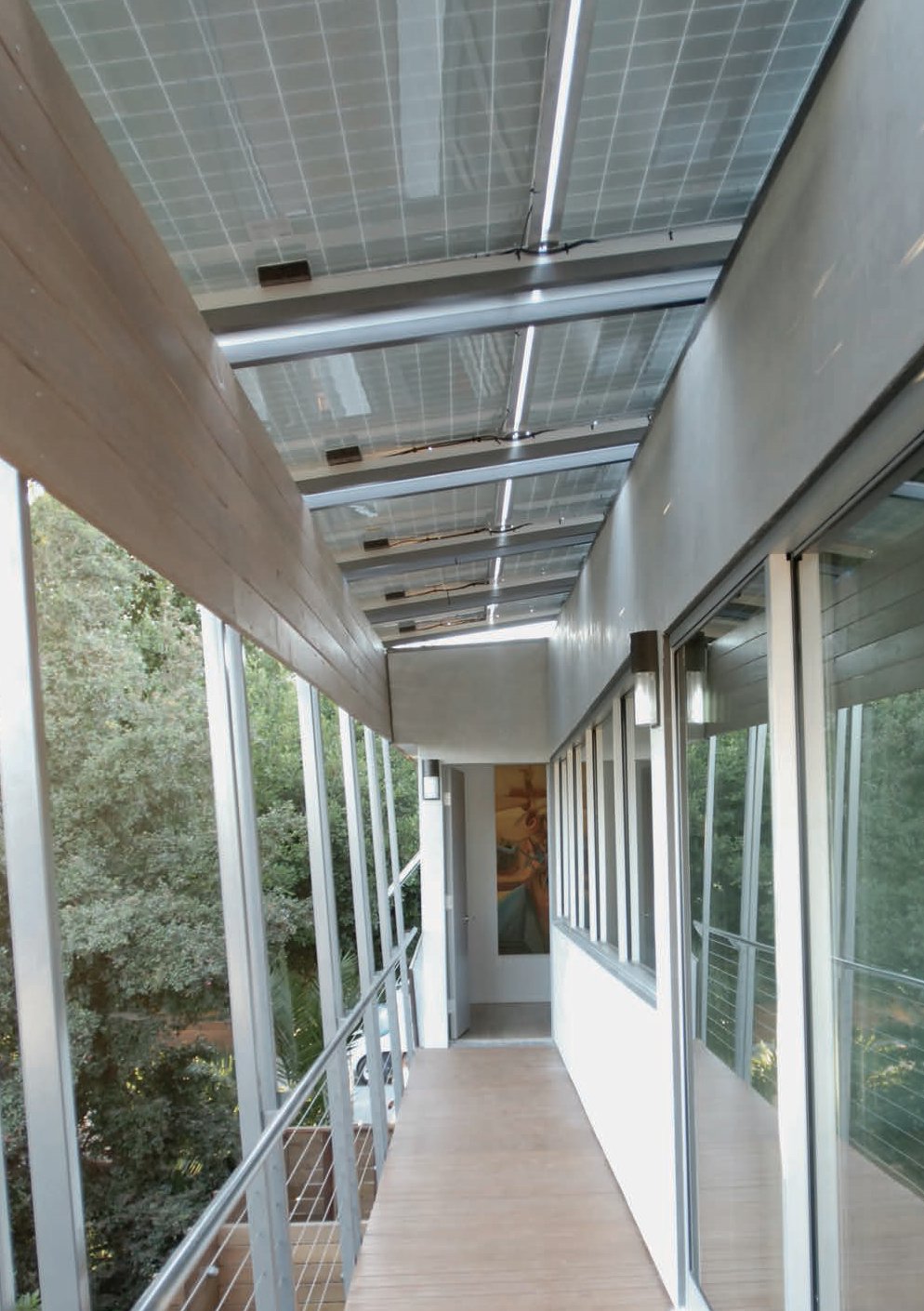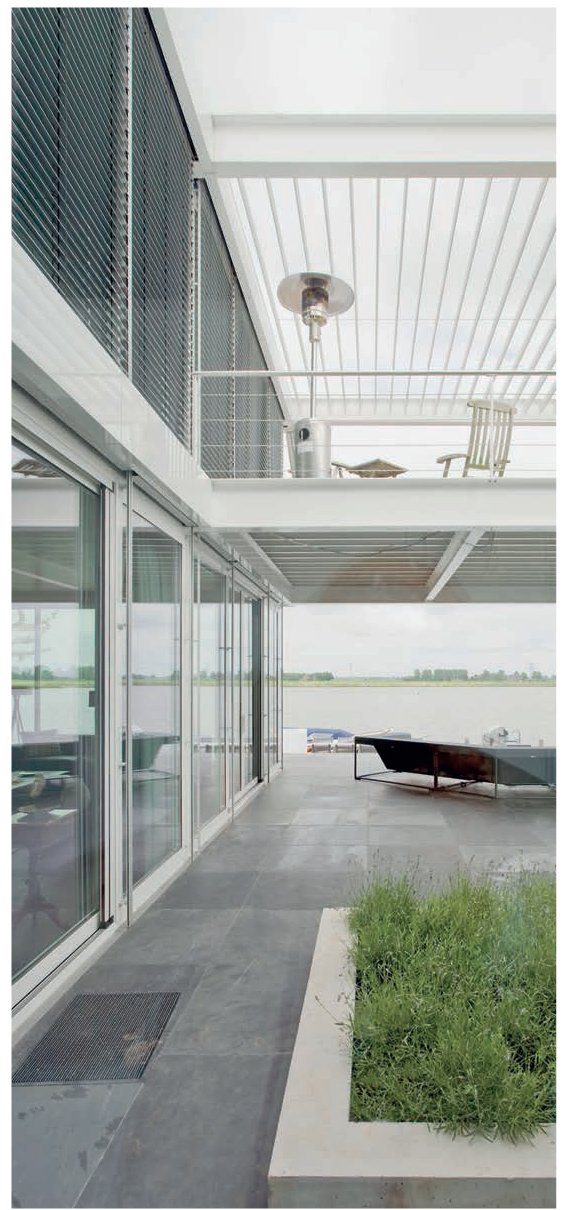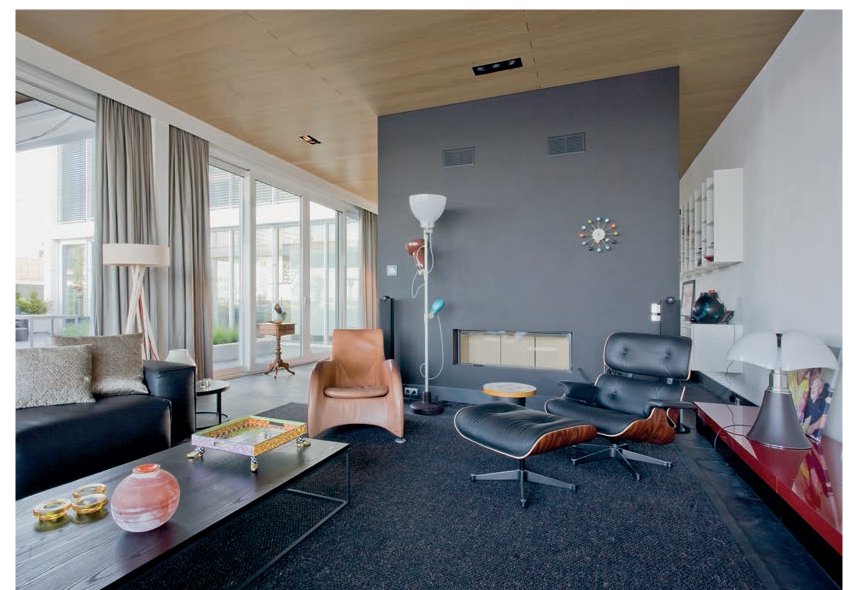The design thrust of a home with a healthy indoor environment is to ensure the occupants’ health and comfort. Aspects such as lighting, ventilation, temperature control and pollutants, among others, are considered in order to prevent conditions that can occur in poorly designed spaces. This can be a challenging task since the standards of comfort are subjective. Despite these variations, there are four key factors that are vital to the design of a space in most situations: thermal comfort, visual comfort, indoor air quality (IAQ)/ventilation and materials selection, each of which will be elaborated on below.
At the outset, a healthy indoor environment must be thermally comfortable. A properly designed thermal system keeps a balance between body heat loss and gain so that a person can maintain homeostasis without effort (Encyclopaedia Britannica 2011a). Due to the subjective nature of what a comfortable temperature is, it is difficult to create conditions that suit every occupant. Therefore, one of the more effective ways to design a thermal system is to control variables that influence indoor temperature and give as much control as possible to the inhabitant. Designers need to consider indoor air temperature, relative humidity, surface or radiant temperature and air speed.
Visual comfort is another important topic in the design of healthy indoor environments, since a lack of consideration can lead to several health problems. Poor lighting for example, can lead to eye strain, headaches, fatigue and lack of concentration. Therefore, it is important to properly consider the visual requirements of each space and design it accordingly. To do this, the design should take into consideration type and quality of light, openings and their control.
Air quality and ventilation is a major consideration. Because people spend 80 to 90 per cent of their time indoors, any polluted or under-circulated air can quickly lead to problems such as allergies, mould, asthma and the transfer of infectious diseases (Craig et al. 2004). To avoid such problems – or what is otherwise known as ‘sick building syndrome’ – it is important to create an airtight building, which prevents unintentional air leakage and achieves maximum control over the airflow (Bas 2004). Furthermore, this extends to other principles, such as expelling pollutants through ventilation, properly filtering indoor air and identifying and removing sources of pollution.

Figure 10.1 The four key factors affecting the indoor environment are noted above.
Finally, building materials and their selection are very important in creating healthy indoor environments. While some materials are harmless, others, from furnishings or certain adhesives used in construction, can give off toxic gases. Sometimes, these toxic fumes are only released for a short period, but in other cases the emission process can last for years. Unfortunately, both natural and man-made materials can be either safe or toxic. Therefore, it is important to select materials based on how their qualities will affect the occupants. Special attention should be given to future maintenance requirements, emission test reports and the production process of the materials.
When the details of a home with a healthy indoor environment are discussed, one needs to recognize that a dwelling’s thermal comfort is reliant upon its air temperature; this is best controlled by a thermostat that can be adjusted to suit the occupants’ needs. Relative humidity is another factor that affects thermal comfort by influencing body heat loss. Differing levels of moisture in the air can affect moisture evaporation resulting in the increase or decrease of the perceptual temperature (Kwok and Grondzik 2007). Therefore, it is recommended that the relative humidity be kept at acceptable levels, which range between 30 per cent and 60 per cent, depending upon the season (Bas 2004).
Surface, or radiant, temperature is also an important consideration. In winter, poor thermal insulation may create cold internal surfaces, necessitating excessively warm air. In summer however, surfaces gain heat through exposure to direct sunlight. Hot surfaces in the house create unwanted increases of indoor air through convection (Encyclopaedia Britannica 2011b). It is therefore necessary to integrate shading devices or take advantage of nearby trees for shading.
Visual comfort is typically based on the type of light that reaches each space. Of the two types of light, daylight and artificial light, daylight is recommended because it is soft, diffused, creates little glare and does not increase the radiant temperature. Despite the advantages of daylight, it is also important to have adequate artificial lighting in each space for nightfall. This artificial light should mimic daylight as closely as possible and should be placed in such a way that it gets maximum distribution. Subsequently, appropriate openings need to be included to increase the amount of natural daylight. This will also improve the internal space’s quality by perceptually extending its size and characteristics into the exterior. Lastly, it is important to control lighting to avoid otherwise unwanted glare or night-time outdoor lights. These can greatly decrease the visual comfort of a dwelling. Tools such as movable shutters, adjustable light fixtures, skylights, high-efficiency lighting, well-illuminated work areas and trees for natural shade are all important in the control of natural and artificial light
Indoor air quality (IAQ) and ventilation are chiefly controlled through the expulsion of pollutants through appropriate ventilation systems. These systems need to be evenly distributed to prevent drafts, varying temperatures between spaces, low circulation areas where pollutants can be gathered and high moisture areas where bacteria and mould can grow. Placing the supply ports far away from the return vents can do this, allowing air to be properly circulated throughout a space before being drawn back into the exhaust vents. Ample air intake into a properly maintained heating, ventilation and air conditioning (HVAC) system – or a system with baseboard heaters and a heat recovery ventilator (HRV) – is also important to ensure that all used air is replaced. Furthermore, since the ventilation systems are often places where pollutants and mould build up, their inherent filtration systems should be regularly cleaned to avoid spreading such problems throughout the house. Special filters to remove gaseous pollutants, such as activated charcoal filters or other absorbent products, are available if needed (Aller Air Purifiers 2009). Lastly, IAQ can be improved by identifying and removing sources of pollution. One way to do this is to ensure that external supply vents are taking in clean outdoor air by placing intake vents away from polluted outdoor sources such as neighbouring exhaust vents.
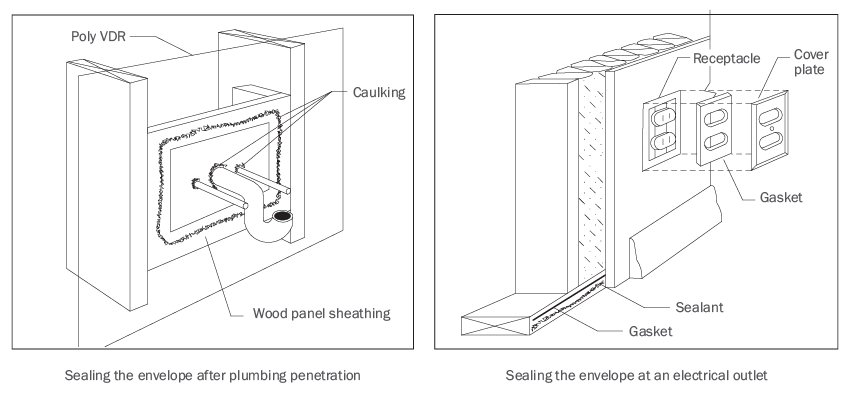
Figure 10.2Measures that can be taken to reduce heat loss by sealing the envelope of a wood-frame building.
While quantifying material pollutant emissions is a new science with many unknown implications, there are still some important general aspects to note. One of them is that neither natural nor fabricated products emit fewer pollutants: each product is unique. For example, chipboard may appear to be environmentally friendly because it is fabricated from woodchips; however, it also uses toxic binders (Public Works and Government Services Canada 2009). Furthermore many natural products degrade faster and therefore may require toxin emitting treatments. Other natural products such as arsenic, formaldehyde and asbestos are inherently toxic and considered dangerous. Therefore, it is necessary to look at emission test reports, which can be found with common materials like carpets and engineered wood products. If an emission test report cannot be found, then the product in question should be chosen with caution, or avoided entirely.
Designers should also be aware that materials that are initially safe might require an application of toxic preservatives in future to extend their life and that such implications should be considered during the initial design phase. Despite the danger of toxic materials, it can be difficult to detect which materials might be harmful since there are some cases where testing is not common or standardized. In these cases, one should look for common factors that might indicate the presence of toxins products, such as adhesives, vinyl, polymerization and foam expansion.
•Increased public interest in indoor air quality
•Use of harmful compounds in construction
•Improved mechanical ventilation systems
•Less reliance on mechanical ventilation vs. fresh air technologies
INNOVATIONS
•Improvement in building science and construction
•New ventilation and heat recovery technologies
•New artificial lighting technologies
•Development of non-emitting bonding materials
10.1 HEALTHY INDOOR ENVIRONMENTS |
|
Project |
NEXTHouse |
Location |
Seattle, Washington, USA |
Architect |
David Vandervort Architects |
The Magnolia neighbourhood in Seattle, Washington is located on hilly terrain in the American Northwest, enclosed by the waters of Elliot Bay and surrounded by views of the Cascade Mountains. This landscape, mixed with the Pacific coastal climate, gave opportunities for the firm David Vandervort Architects to design a healthy and comfortable dwelling. The project NEXTHouse was constructed on a plot after an existing home was demolished due to its inability to meet the occupants’ needs. The new house, measuring 228 m2 (2,750 sq ft), was designed with principles of healthy living in mind, both for the dwellers and the environment at large.
The NEXTHouse is orientated east–west to take full advantage of the southern sun exposure. While the region is known for a large amount of precipitation and clouds, window openings have been placed all around the three-storey house to provide adequate natural light and to minimize the use of artificial illumination. The combination of the centrally located stairwell and the clerestory windows on the higher level triggers a ‘stack effect’ to create an upper draft between the floors to further cool down the dwelling in the summer.
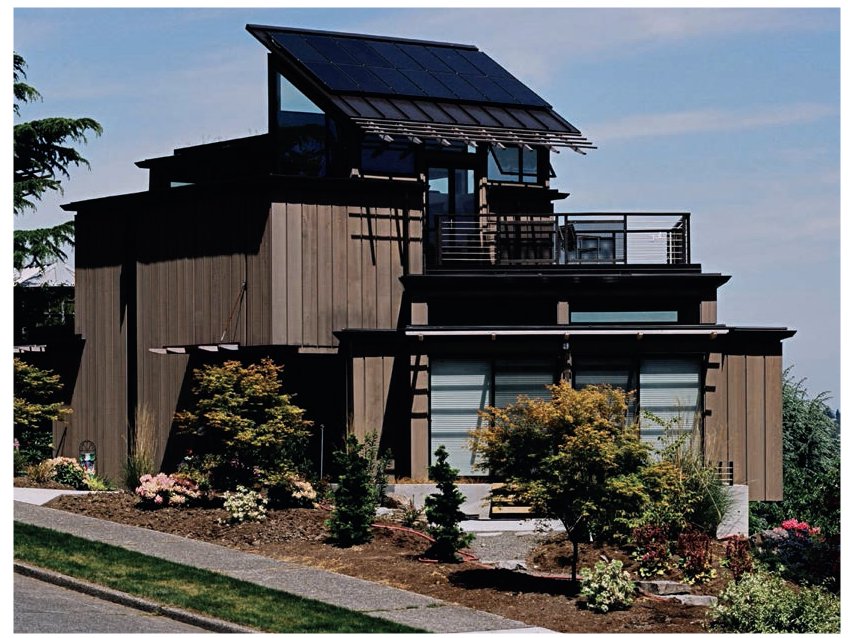
The NEXTHouse is oriented east-west to take full advantage of the southern sun exposure.
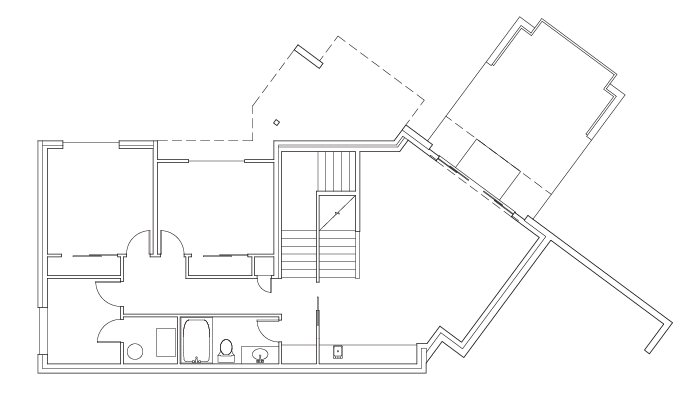
The lower level includes the bedrooms.
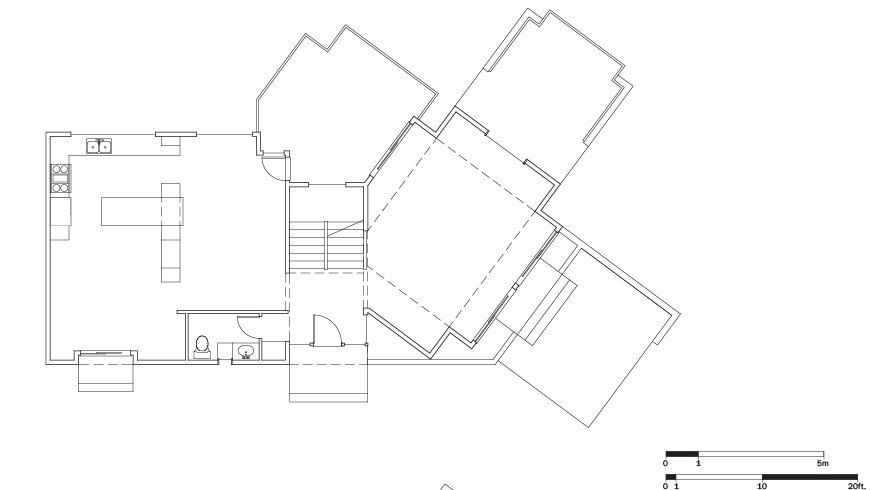
The NEXTHome was divided into three areas: Living, working and sleeping.
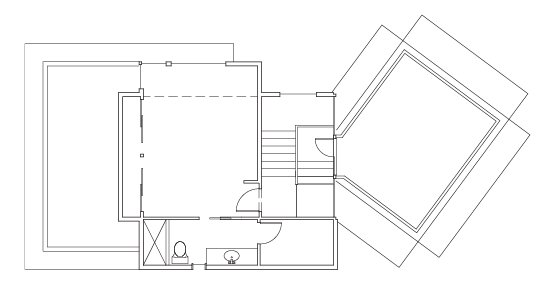
Upper floor.
The design consists of three main zones: living, working and sleeping. Each space has openings that lead to patios and decks to provide access to the outdoors. Overhanging roofs act as a shading device that prevents overexposure to sunlight, which could cause an uncomfortable glare. By using components with low volatile organic compound (VOC) paint finishes and formaldehyde-free plywood, all the materials that were used in the interior are non-toxic and provide a healthy indoor environment. It is also worth noting that the NEXTHouse was constructed using materials that were recycled from the house that previously stood on the site.
To ensure a comfortable indoor temperature in the changing seasons, walls are insulated with sprayed polyurethane foam, while a hydronic radiant heating system was installed in the floors. Furthermore, the green roof contains vegetation that helps lower heating needs and offers additional insulation. In the winter months, when the windows are closed, a heat exchange ventilation system assists in the circulation to further improve airflow and foster healthy indoor air. The roof also integrates a 1-kW, thin film of solar array and includes a metering system that allows the occupants to be aware of their energy generation and consumption.

No materials with Volatile Organic Compounds (VOCs) were used in construction.
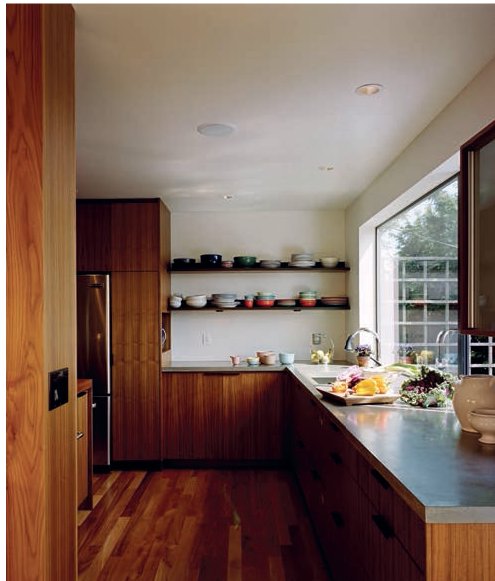
The house was constructed with materials that were recovered from an old dwelling that stood on the same site.
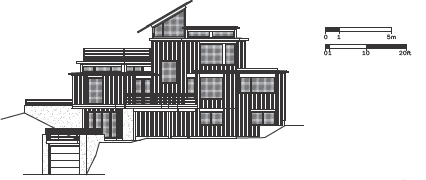
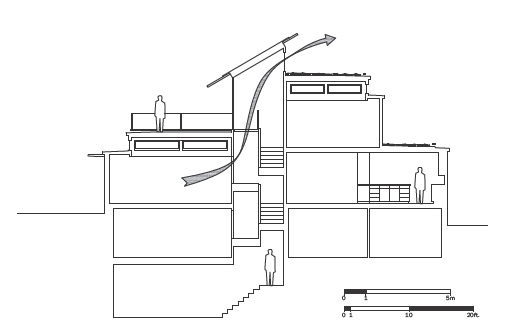
The stairwell and the clerestory triggers a stack effect and a draught between the floors.

View of the rear porch.
10.2 HEALTHY INDOOR ENVIRONMENTS | |
Project |
Steel Study House II |
Location |
Leeuwarden, The Netherlands |
Architect |
Archipelontwerpers |
Built on the perimeter of Leeuwarden, in the north of Holland, Steel Study House II is situated in a transitional space between an urban area and agricultural land. For this reason, it defies the typical morphology of its locale and is built surrounding an open-air patio, which operates as a central hub, as a way of embodying that transition. The layout intersperses enclosed areas with wide open spaces connected to the outside, and many spaces are only partly bound by walls.
The facades of Steel Study House II differ based on their position in relation to the urban and open areas. The western facade, which faces the town, is designed to integrate with surrounding buildings. A ramp allows entrance from the pavement and public urban areas, but motorized blinds have been installed to allow the inhabitants to visually cut off the built environment should they choose. The opposite facade, on the other hand, includes breathtaking views of wide-open, uninhabited spaces and the adjacent lake.
All of the rooms in the house also have a view of the interior patio, further breaking the separation between room and open space. As a result, each room has at least some direct connection to the open air. This gives the inhabitants a sense of always being part of a larger open space. Passage from room to room will often take the occupant through one or more open area, thus ensuring that the air is always fresh.
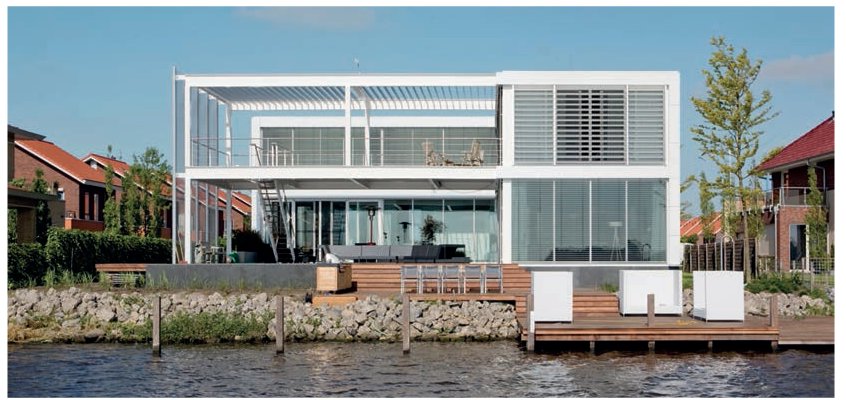
The rear elevation faces the water.
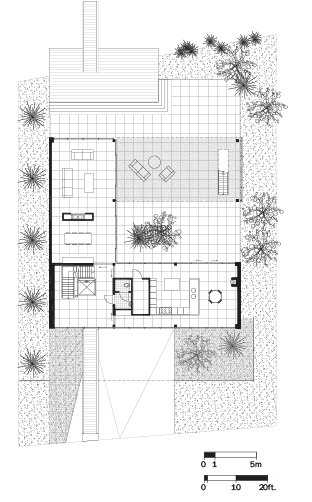
The house is situated in a transitional space between urban and agricultural areas.
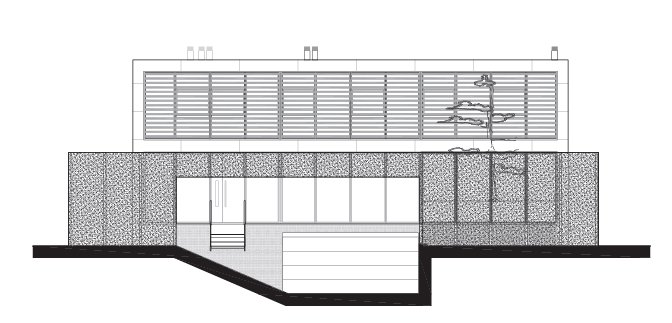
East elevation

A section showing the entrance ramp.
A view of the patio that faces the water.
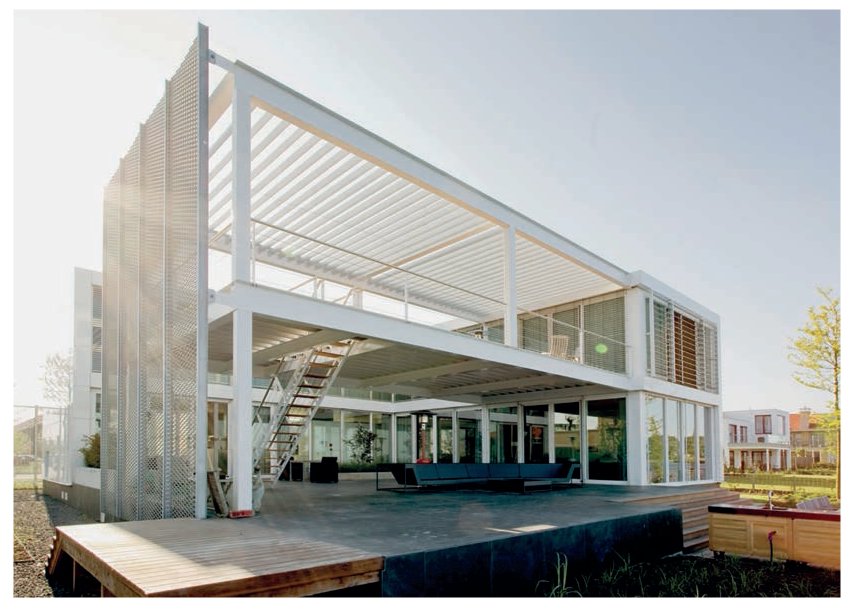
All the rooms in the house have views of the interior patio.
The open plan design lets air circulate.
